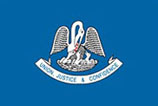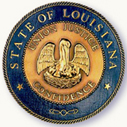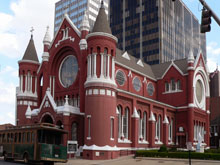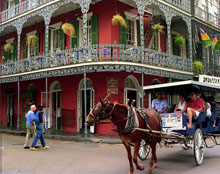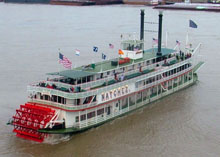About Louisiana
Louisiana is a Southern state of the United States. The capital is Baton Rouge and the largest city is New Orleans. The state is bordered to the west by the state of Texas; to the north by Arkansas; to the east by the state of Mississippi; and to the south by the Gulf of Mexico. Louisiana is home to many distinct cultures; especially notable are the Louisiana Creole people and the French-speaking Cajun.
Louisiana has a humid subtropical climate, perhaps the most “classic” example of a humid subtropical climate of all the Southeastern states, with hot summers and mild winters. The subtropical characteristics of the state are due in large part to the influence of the Gulf of Mexico, which even at its farthest point is no more than a couple hundred miles away. Louisiana is often affected by tropical cyclones and is very vulnerable to strikes by major hurricanes, especially the low area around and in the New Orleans area. The area is also prone to frequent thunderstorms, especially in the summer. The entire state averages over 60 days of thunderstorms a year averaging more thunderstorms than any other state except Florida. Louisiana averages 27 tornadoes annually, and the entire state is vulnerable to a tornado strike, with the extreme southern portion of the state slightly less vulnerable than the rest of the state.
Louisiana was named after Louis XIV, one of France’s greatest and most powerful kings. After René-Robert Cavelier, Sieur de La Salle claimed the territory drained by the Mississippi River; he named it La Louisiane, meaning “Land of Louis”. Most of the territory to the east of the Mississippi was lost to the Kingdom of Great Britain in the French and Indian War, except for the area around New Orleans and the parishes around Lake Pontchartrain. The rest of Louisiana became a colony of Spain after the Seven Years’ War by the Treaty of Paris of 1763.
In 1803, Bonaparte sold the territory to the United States, which divided it into two territories: the Orleans Territory (which became the state of Louisiana in 1812) and the District of Louisiana (which consisted of all the land not included in Orleans Territory). The Florida Parishes were annexed from the short-lived and strategically important West Florida Republic by proclamation of President James Madison in 1810.
Louisiana was a slave state. In the American Civil War, Louisiana seceded from the Union on January 26, 1861. New Orleans was captured by Federal troops on April 25, 1862. Because a large part of the population had Union sympathies (or compatible commercial interests), the Federal government took the unusual step of designating the areas of Louisiana under federal control as a state within the Union, with its own elected representatives to the U.S. Congress.
Louisiana is unique among U.S. states in its method for state, local, and congressional elections. All candidates, regardless of party affiliation, run in an open primary on Election Day. If no candidate has more than 50% of the vote, the two candidates with the highest vote total compete in a runoff election approximately one month later. This runoff does not take into account party identification; therefore, it is not uncommon for a Democrat to be in a runoff with a fellow Democrat or a Republican to be in a runoff with a fellow Republican.
The state’s principal agricultural outputs include seafood (It is the biggest producer of crawfish in the world), cotton, soybeans, cattle, sugarcane, poultry and eggs, dairy products, and rice. Its industrial outputs include chemical products, petroleum and coal products, food processing, transportation equipment, paper products, and tourism.
$state_id = ‘LA’ ;
global $state_id ;
[/insert_php]
[insert_php]
$state_id = ‘LA’ ;
[/insert_php]


